2025.05.12
- Features
-
Services/ProductsServices/ProductsServices/Products

Learn more about the retail trading conditions, platforms, and products available for trading that FXON offers as a currency broker.
You can't start without it.
Trading Platforms Trading Platforms Trading Platforms
Features and functionality comparison of MetaTrader 4/5, and correspondence table of each function by OS
Two account types to choose
Trading Account Types Trading Account Types Trading Account Types
Introducing FXON's Standard and Elite accounts.
close close

-
SupportSupportSupport

Support information for customers, including how to open an account, how to use the trading tools, and a collection of QAs from the help desk.
Recommended for beginner!
Account Opening Account Opening Account Opening
Detailed explanation of everything from how to open a real account to the deposit process.
MetaTrader4/5 User Guide MetaTrader4/5 User Guide MetaTrader4/5 User Guide
The most detailed explanation of how to install and operate MetaTrader anywhere.
FAQ FAQ FAQ
Do you have a question? All the answers are here.
Coming Soon
Glossary Glossary GlossaryGlossary of terms related to trading and investing in general, including FX, virtual currencies and CFDs.
News News News
Company and License Company and License Company and License
Sitemap Sitemap Sitemap
Contact Us Contact Us Contact Us
General, personal information and privacy inquiries.
close close

- Promotion
- Trader's Market
- Partner
-
close close
Learn more about the retail trading conditions, platforms, and products available for trading that FXON offers as a currency broker.
You can't start without it.
Features and functionality comparison of MetaTrader 4/5, and correspondence table of each function by OS
Two account types to choose
Introducing FXON's Standard and Elite accounts.
Support information for customers, including how to open an account, how to use the trading tools, and a collection of QAs from the help desk.
Recommended for beginner!
Detailed explanation of everything from how to open a real account to the deposit process.
The most detailed explanation of how to install and operate MetaTrader anywhere.
Do you have a question? All the answers are here.
Coming Soon
Glossary of terms related to trading and investing in general, including FX, virtual currencies and CFDs.
General, personal information and privacy inquiries.
Useful information for trading and market information is posted here. You can also view trader-to-trader trading performance portfolios.
Find a trading buddy!
Share trading results among traders. Share operational results and trading methods.
- Legal Documents TOP
- Client Agreement
- Risk Disclosure and Warning Notice
- Order and Execution Policy
- Complaints Procedure Policy
- AML/CFT and KYC Policy
- Privacy Policy
- eKYC Usage Policy
- Cookies Policy
- Website Access and Usage Policy
- Introducer Agreement
- Business Partner Agreement
- VPS Service Terms and Condition

This article was :
published
updated
Weekly FX Market Review and Key Points for the Week Ahead
In the foreign exchange market for the week that ended on May 11th, the dollar strengthened against the yen. While the Federal Open Market Committee (FOMC) kept its policy interest rate unchanged, the Bank of England (BOE) decided to cut the interest rate. A trade agreement between the U.S. and the U.K. also helped strengthen the dollar. As a result, the USDJPY reached the 146 yen range. However, the pair was then pushed back as traders corrected their positions.
Meanwhile, although the GBPUSD was firm following the BOE's decision, the euro and the pound weakened slightly against the dollar.
May 5 (Mon)
The sell-off in the dollar dominated the USDJPY. After reaching the 145 yen range on May 2nd, the pair failed to move higher on Monday but instead fell to the middle of the 143 yen range. The EURUSD reached the 1.13 range but was then pushed back to the 1.129 range. The GBPUSD failed to stay within the 1.33 range but instead fluctuated within the 1.32 range throughout the day.
May 6 (Tue)
Traders corrected their positions ahead of the May 7th FOMC meeting. The USDJPY extended its decline to the 142.3 yen range.
In Germany, Friedrich Merz was elected as the new chancellor in the second round of voting after failing to secure the position in the first voting. This news prompted traders to buy the euro, with the EURUSD jumping to the 1.138 range during the trading hours.
Meanwhile, the weakening dollar helped the GBPUSD reach a new high of 1.3402.
May 7 (Wed)
The FOMC decided to keep the policy interest rate unchanged. In addition, Federal Reserve Chairman Jerome Powell stated that the central bank would not have to be in a hurry to make another rate cut. As a result, the USDJPY jumped to 144.0 yen. The strengthening dollar pushed the EURUSD down to the 1.129 range and the GBPUSD down to the 1.32 range.
May 8 (Thu)
Traders turned risk-on to buy the dollar following media reports that the U.S. and U.K. would reach a trade agreement. The USDJPY surged as high as 146.17 yen.
Conversely, the news triggered a sell-off in the euro and the pound. The EURUSD fell to the 1.121 range. The GBPUSD also fell to the 1.323 range.
May 9 (Fri)
After some media outlets reported that the U.S. and China would start the trade talks, the market went into a wait-and-see atmosphere. Additionally, the dollar was sold for profit-taking. As a result, the USDJPY slid from 146 yen to 144.83 yen during the trading hours.
Meanwhile, the EURUSD rebounded to the 1.129 range before being pushed back to the 1.124 range. The GBPUSD closed the weekly trading session by bouncing back to the 1.329 range.
Economic Indicators and Statements to Watch this Week
(All times are in GMT)
May 13 (Tue)
- 11:30 U.S.: April Consumer Price Index (CPI)
- 11:30 U.S.: April Consumer Price Index (CPI Core Index)
May 15 (Thu)
- 06:00 U.K.: January-March Quarterly Gross Domestic Product (preliminary GDP)
- 06:00 U.K.: March Monthly Gross Domestic Product (GDP)
- 09:00 Europe: January-March Quarterly Regional Gross Domestic Product (revised regional GDP)
- 12:30 U.S.: April retail sales
- 12:30 U.S.: April retail sales (excluding automotives)
- 12:40 U.S.: Press conference by Federal Reserve Board (FRB) Chairman Jerome H. Powell
- 23:50 Japan: January-March Quarterly Gross Domestic Product (preliminary GDP)
This Week's Forecast
The following currency pair charts are analyzed using an overlay of the ±1σ and ±2σ standard deviation Bollinger Bands, with a 20-period moving average.
USDJPY
The FRB decided to leave its key interest rate unchanged. Also, Chairman Powell maintained his cautious stance on further monetary easing. If the U.S. makes few compromises in trade talks with China, the sell-off in the dollar is likely to accelerate as more traders turn risk-off.
Next is an analysis of the USDJPY daily chart.
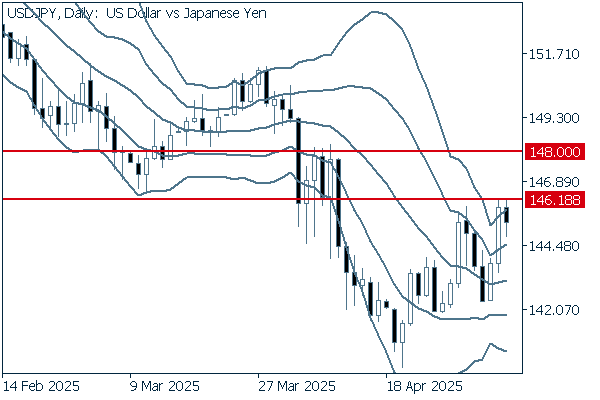

Last week, the pair broke above the 146 yen level. Also, the middle line has turned upward, although its angle is quite low. If the pair clearly crosses above the 146.18 yen level, it will likely try to climb as high as 148 yen.
We continue with an analysis of the USDJPY weekly chart.
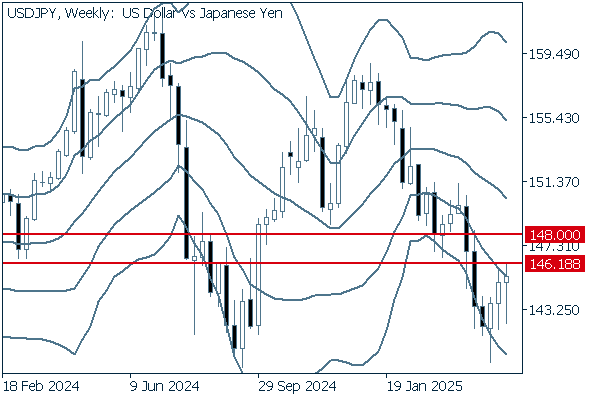

On the weekly chart, three consecutive positive candlesticks have appeared. However, overall, the pair is still in a downtrend. If the pair clearly breaks above the current resistance line located at the 146.18 yen level, it is likely to move towards the 148 yen level, where profit-taking is expected. Unless the pair crosses above the middle line, it is safe to say that the downtrend will continue.
EURUSD
The euro's rally has come to a halt, and the euro is weakening against the dollar. How the EURUSD will move may depend on the outcome of the trade talks between the U.S. and China. The dollar's behavior will continue to dominate the market.
Next is an analysis of the EURUSD daily chart.
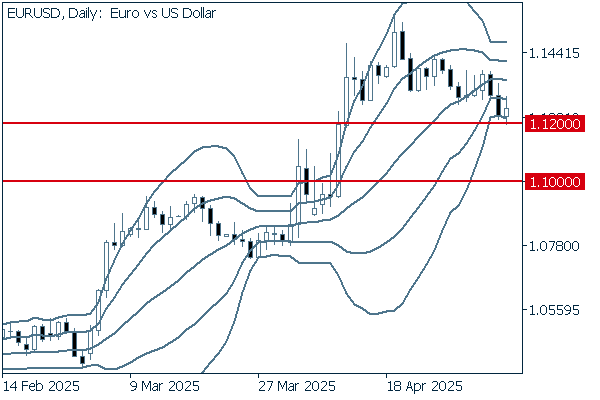

Last week, the declining pair touched -2σ. Although there is a possibility of a rebound from here, it is important to pay attention to the narrowing bandwidth. If the pair clearly breaks below the current support line located at the 1.12 level, the pair is likely to fall as low as the psychological support line located at the 1.10 level.
We continue with an analysis of the EURUSD weekly chart.
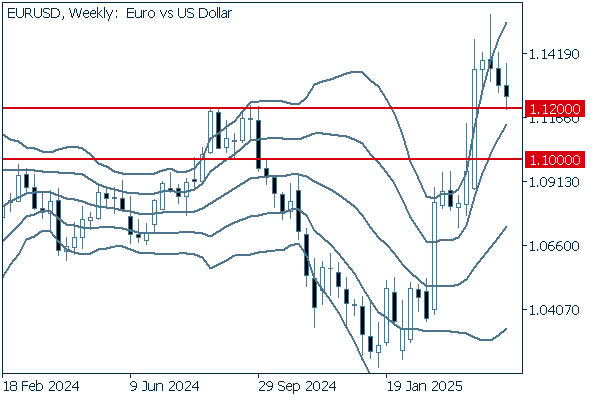

On the weekly chart, three consecutive negative candlesticks have appeared. The line at the 1.12 level, formerly a resistance line, now serves as a support line. It is important to see whether the pair will rebound from this level or clearly break below the line. In the case of the former, the pair may rally to the 1.14 level. Otherwise, the pair could plummet to the 1.10 level.
GBPUSD
On May 8th, the BOE announced a 0.25% rate cut, the fourth in a row. On May 15th, quarterly and monthly GDP figures for the U.K. will be released. If the quarterly GDP growth rate misses expectations, the pound will be sold off.
Now, we analyze the daily GBPUSD chart.


While the bandwidth is narrowing, the pair is hovering on the middle line. The line at 1.32, originally a resistance line, can now also be considered a support line. If the pair clearly breaks below this line, it will enter a downtrend after a correction phase.
We continue with an analysis of the GBPUSD weekly chart.
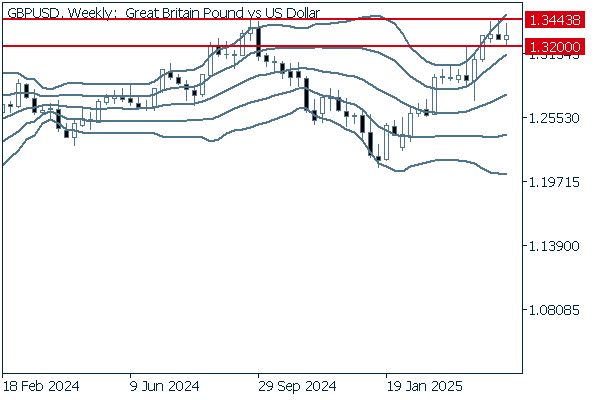

The pound's uptrend has paused, and it is facing strong selling pressure. The middle line remains upward. However, if the pair clearly breaks below the 1.32 level, it could fall to the 1.30 level.
Was this article helpful?
0 out of 0 people found this article helpful.
Thank you for your feedback.
FXON uses cookies to enhance the functionality of the website and your experience on it. This website may also use cookies from third parties (advertisers, log analyzers, etc.) for the purpose of tracking your activities. Cookie Policy
